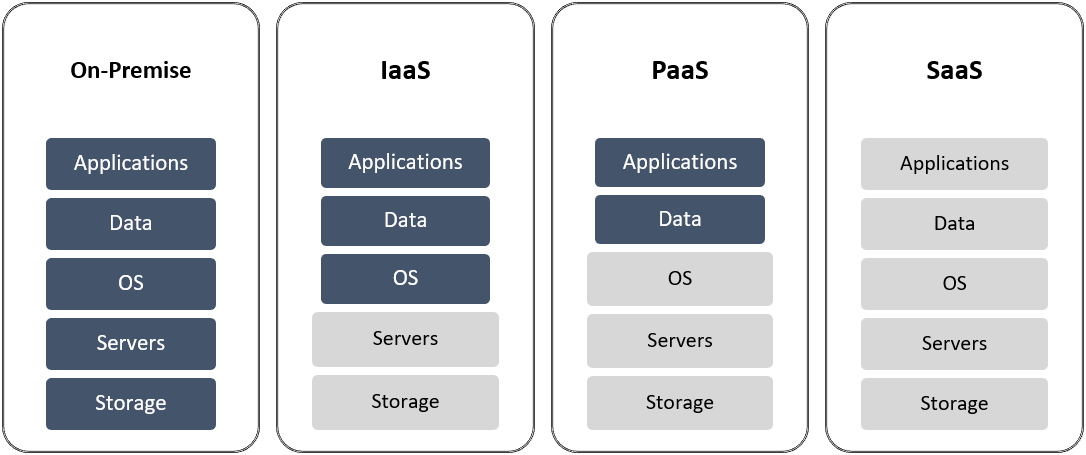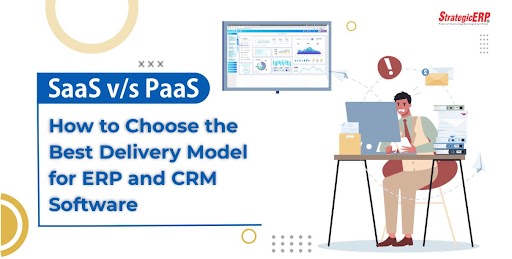SaaS vs PaaS: How to Choose the Best Delivery Model for ERP and CRM Software
Category : CRM
Blog posted by : Admin / 02 Sep, 2021
A quick search for either ERP or CRM software, often throws such terms at you- SaaS CRM or PaaS. As if an acronym for customer relationship management was not enough, now customers have to deal with more acronyms! Clearly, reading short descriptions of SaaS vs Paas will not help you gauge which one is more suited to your business.
This blog will not only help you understand the basics but will also compare minor differences between the two, so you are fully equipped to choose the right kind of automation solution.
Before taking a deep dive into the SaaS vs PaaS world, it would be helpful to take a step back and gain some perspective.
Digital transformation is the automation of business processes from start to end, generally by deploying either an ERP or CRM software. A service provider can offer a few different ways to upgrade your business workflows.
As a business executive, you first need to decide who will handle your-
-
Data
-
Infrastructure
-
Maintenance
SaaS in cloud computing is increasingly being adopted for data storage and computing whereas infrastructure and maintenance can either be handled by business owners or by the service providers.
An enterprise resource management or CRM software can be offered in the following ways:
-
On-premise
-
IaaS: Infrastructure as a service
-
PaaS: Platform as a service
-
SaaS: Software as a service
On-premise: Hardware and software that is installed and managed in the same premises as your business.
IaaS: Self- service model. Purchase hardware and software resources as and when needed.
PaaS: You manage and create applications. Service provider delivers a framework upon which you develop applications with minimal input.
SaaS application: Completely managed by a third-party over the internet, including data computing, storage and maintenance.
On-premise is generally the type of model that businesses want to transform into a more functional model, whereas IaaS provides the most amount of control and scalability when opting for digital transformation.

Figure 1: For an on-premise set-up, the functions listed above are managed by the business enterprise whereas for a SaaS application, the listed functions are managed by the service provider
This blog will be exploring SaaS vs. PaaS as these two are the ones that are most popular due to their quick deployment and minimal maintenance and infrastructure costs. What you will learn here:
-
Descriptions of each
-
Differences in the advantages offered by both
-
Examples: SaaS ERP and CRM
-
SaaS vs PaaS: The more popular one!
There is one similarity between the Software as a Service and Platform as a Service delivery models. Both are web-based services delivered to clients over the internet. What differentiates them is the amount of control the buyer has over various components of the software.
Depending on the resources, requirements and technical knowledge your team possesses, you can opt for a ready-to-use model (Software as a Service) or a partially do-it-yourself model (Platform as a Service).
A SaaS application is made available to the buyer through the internet and does not require any downloads. It is generally offered as a monthly subscription and requires a period of training and implementation.
The software is generally offered on a cloud-based platform, which is taken care of by the SaaS company including data computing, storage, maintenance and support. The buyer only needs to log in through the web and start using the software.
Platform as a Service is a framework delivered over the web upon which the clients build applications for use. Instead of delivering software that is readily usable, PaaS delivers a platform which enables the client’s team of developers to create customized applications called middleware, with minimum effort.
As with SaaS, a PaaS platform is also maintained and supported by the provider along with the storage and middleware. When it comes to managing the custom applications and data, the client is responsible for it, unlike in the Software as a Service model.
Both delivery models of business automation offer flexibility and minimum effort when it comes to managing customers or employees but SaaS in cloud computing is preferred by many organizations for carrying out storage, computing and other functions.
Instead of directly comparing SaaS vs PaaS, the table below provides a list of the minor differences in the similar benefits offered by both.
|
SaaS (Software as a Service) |
|
PaaS (Platform as a Service)
|
|
All customization is carried out by the provider who tweaks the software according to the client’s needs |
|
Highly customizable as the in-house team can develop middleware as and when required |
|
|
|
|
|
Requires no technical knowledge to operate |
|
Requires coding as developers build applications on the platform’s network |
|
|
|
|
|
You rent the application from a SaaS company |
|
You rent space on the platform provided by the company |
|
|
|
|
|
Perfect for small businesses as it can be used instantly and the client does not need to invest time on software |
|
Perfect for an organization that would like control over its applications and data, which can be customized to a higher degree. |
|
|
|
|
|
It is scalable but need to contact the service provider to add more users |
|
Highly scalable as the in-house team is responsible for developing the apps |
|
|
|
|
|
Very cost effective due to low level of customization |
|
Lowes the cost of developing applications and reduces time due to its ready framework |
|
|
|
|
|
Great option for short term use as minimum cost and effort required by the client |
|
Good option for a business with changing requirements and many developers working on the same project |
|
|
|
|
|
Frees up the client’s time to focus on the operations and management of the business |
|
Frees up the employee’s time to focus on building highly effective and customized software |
|
|
|
|
|
Suitable for end-users |
|
Suitable for developers |
As both models are developed with unique features, you need to figure out which PaaS or SaaS application will fit your business needs.
SaaS in cloud computing has become the model of choice over PaaS, for companies that do not want to invest time and money in development and maintenance. A common example of SaaS based models of delivery are CRM and ERP software.
An example of a PaaS delivery model would be a real estate company that requires a highly specific application for their organization. If spending a little extra for more innovation is worth the investment then PaaS would be the ideal choice. For businesses with limited time and budget, SaaS ERP would be the ideal choice.
For any business that requires customer relationship management or enterprise resource planning software, a SaaS based model is very popular.
A SaaS company offers many applications to streamline the workflow of a business:
-
Customer relationship management- Lead nurturing and sales automation
-
Human resource and payroll management- Recruitment, attendance and payroll
-
Inventory management- Purchasing, stocking and delivery
SaaS ERP is the most convenient way to manage your business. Buyers are not only tempted by the factor of convenience but cost too. Without investing in infrastructure or additional manpower, you receive licensed software that is ready to be deployed.
When the convenience of SaaS is offered as a cloud service, it becomes the perfect solution for clients, vendors and customers. Take for instance, a client purchases CRM software as a service that is offered on cloud. The client will be paying a monthly subscription fee for as long as they are using the SaaS CRM software, which will be instantly accessible through the web or mobile phones. Any user can sign into the online system with the right credentials.
An increase in productivity, real-time collaboration, data analytics, cost effective and secure access is what makes a cloud-based SaaS CRM and other applications popular.







